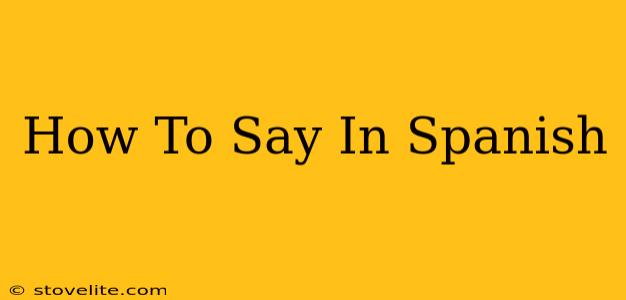Learning a new language can be exciting, and Spanish, with its rich culture and global presence, is a popular choice. This guide will help you master saying specific words and phrases in Spanish, covering various aspects to ensure you speak confidently and correctly.
Understanding Spanish Verb Conjugation: The Key to Fluency
Spanish verbs are conjugated, meaning they change form depending on the subject (I, you, he/she/it, we, you all, they). This is crucial for constructing grammatically correct sentences. Let's break it down with some examples. We'll use the verb "to be" (ser/estar) as a starting point, as it's fundamental.
Ser vs. Estar: The Two "To Be" Verbs
Spanish has two verbs that translate to "to be" in English: ser and estar. They are NOT interchangeable.
-
Ser: This verb describes inherent qualities, origin, and time. Think of it as describing something permanent or essential.
- Yo soy: I am
- Tú eres: You are (singular informal)
- Él/Ella/Usted es: He/She/You (formal) is
- Nosotros somos: We are
- Vosotros sois: You are (plural informal, used in some regions)
- Ellos/Ellas/Ustedes son: They/You (plural formal) are
-
Estar: This verb describes temporary states, locations, and emotions. It indicates something that's changeable or circumstantial.
- Yo estoy: I am
- Tú estás: You are (singular informal)
- Él/Ella/Usted está: He/She/You (formal) is
- Nosotros estamos: We are
- Vosotros estáis: You are (plural informal, used in some regions)
- Ellos/Ellas/Ustedes están: They/You (plural formal) are
Common Phrases and Their Spanish Equivalents
Here are some frequently used phrases and their translations, categorized for easier learning:
Greetings and Farewells
- Hello: Hola
- Good morning: Buenos días
- Good afternoon: Buenas tardes
- Good evening/Good night: Buenas noches
- Goodbye: Adiós
- See you later: Hasta luego
- See you soon: Hasta pronto
- Take care: Cuídate
Basic Conversation Starters
- What is your name?: ¿Cómo te llamas? (informal) / ¿Cómo se llama usted? (formal)
- My name is…: Me llamo…
- How are you?: ¿Cómo estás? (informal) / ¿Cómo está usted? (formal)
- I am fine, thank you: Estoy bien, gracias.
- Please: Por favor
- Thank you: Gracias
- You're welcome: De nada
Essential Questions
- Where is the bathroom?: ¿Dónde está el baño?
- How much does this cost?: ¿Cuánto cuesta esto?
- Do you speak English?: ¿Habla inglés?
- I don't understand: No entiendo.
- Help!: ¡Ayuda!
Tips for Mastering Spanish
- Practice regularly: Consistent effort is key. Try speaking Spanish daily, even if it's just for a few minutes.
- Immerse yourself: Surround yourself with Spanish language media, such as movies, music, and podcasts.
- Use language learning apps: Apps like Duolingo and Babbel can provide structured lessons and practice.
- Find a language partner: Practicing with a native speaker can significantly accelerate your learning.
- Don't be afraid to make mistakes: Mistakes are a natural part of the learning process. Embrace them and learn from them.
By consistently applying these tips and using the information provided in this guide, you'll be well on your way to confidently expressing yourself in Spanish. Remember to replace "[Word or Phrase]" in the title with the specific word or phrase you want to learn how to say in Spanish. Good luck!

